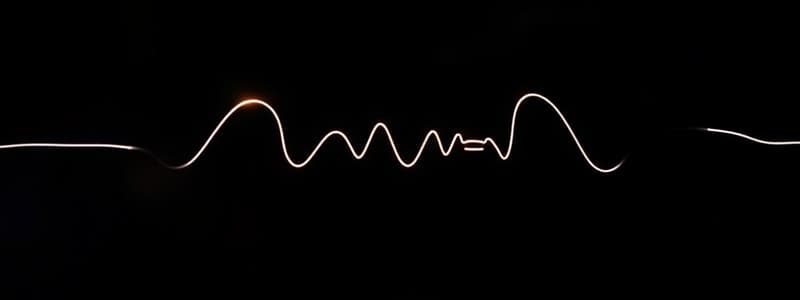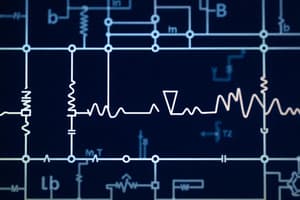Podcast
Questions and Answers
What is the value of Vx based on the applied Kirchhoff's second law?
What is the value of Vx based on the applied Kirchhoff's second law?
- 4 V
- 2 V (correct)
- 0 V
- 6 V
Which step is essential before applying Kirchhoff's laws when dealing with resistors?
Which step is essential before applying Kirchhoff's laws when dealing with resistors?
- Calculate equivalent resistance if in series or parallel (correct)
- Identify the voltage sources
- Label all components in the circuit
- Assume all currents are zero
What is the current intensity I1 calculated, which is greater than zero?
What is the current intensity I1 calculated, which is greater than zero?
- 0 A
- 2.5 A
- 1.5 A (correct)
- 1.0 A
What conclusion can be drawn if the calculated current is negative?
What conclusion can be drawn if the calculated current is negative?
What should be done after applying Kirchhoff's second law for several loops?
What should be done after applying Kirchhoff's second law for several loops?
What does Kirchhoff's First Law state about the electric current at a node in a closed circuit?
What does Kirchhoff's First Law state about the electric current at a node in a closed circuit?
How is the electric current intensity defined in Kirchhoff's First Law?
How is the electric current intensity defined in Kirchhoff's First Law?
Given the currents 4 A, 5 A, and 2 A entering a node, what is the resulting current intensity assuming it is denoted as I and follows Kirchhoff's First Law?
Given the currents 4 A, 5 A, and 2 A entering a node, what is the resulting current intensity assuming it is denoted as I and follows Kirchhoff's First Law?
What is the algebraic sum of electric currents at a node in a closed circuit according to Kirchhoff's First Law?
What is the algebraic sum of electric currents at a node in a closed circuit according to Kirchhoff's First Law?
In Kirchhoff's First Law, how is current flowing into a node represented?
In Kirchhoff's First Law, how is current flowing into a node represented?
What does Kirchhoff's Second Law relate to in electrical circuits?
What does Kirchhoff's Second Law relate to in electrical circuits?
Which of the following equations describes Kirchhoff's First Law mathematically?
Which of the following equations describes Kirchhoff's First Law mathematically?
What does electromotive force (VB) represent in a closed circuit?
What does electromotive force (VB) represent in a closed circuit?
According to Kirchhoff's second law, what is true about a closed loop?
According to Kirchhoff's second law, what is true about a closed loop?
When calculating VB using the formula VB = I (R + r), what do R and r represent?
When calculating VB using the formula VB = I (R + r), what do R and r represent?
Which statement is NOT true when using Kirchhoff's second law?
Which statement is NOT true when using Kirchhoff's second law?
In the context of Kirchhoff's law, what sign does the emf take if the assumed current direction is from negative to positive inside the source?
In the context of Kirchhoff's law, what sign does the emf take if the assumed current direction is from negative to positive inside the source?
How is the total potential difference defined in a closed loop according to Kirchhoff's second law?
How is the total potential difference defined in a closed loop according to Kirchhoff's second law?
What must you assume when applying Kirchhoff's second law to a closed loop?
What must you assume when applying Kirchhoff's second law to a closed loop?
How is the relationship between electromotive force and potential difference summarized?
How is the relationship between electromotive force and potential difference summarized?
Which equation correctly expresses Kirchhoff's second law?
Which equation correctly expresses Kirchhoff's second law?
Flashcards
Kirchhoff's First Law (Current Law)
Kirchhoff's First Law (Current Law)
The total current entering a node (junction) in a circuit equals the total current leaving the node.
Kirchhoff's Second Law (Voltage Law)
Kirchhoff's Second Law (Voltage Law)
The sum of all voltage drops (potential differences) around a closed loop (circuit) is equal to the sum of all voltage sources in that loop.
Node (Junction)
Node (Junction)
The point in an electrical circuit where two or more wires connect.
Conventional Current Direction
Conventional Current Direction
Signup and view all the flashcards
Potential Difference (Voltage)
Potential Difference (Voltage)
Signup and view all the flashcards
Resistance
Resistance
Signup and view all the flashcards
Electric Current
Electric Current
Signup and view all the flashcards
Kirchhoff's Voltage Law (KVL)
Kirchhoff's Voltage Law (KVL)
Signup and view all the flashcards
Kirchhoff's Current Law (KCL)
Kirchhoff's Current Law (KCL)
Signup and view all the flashcards
Resistors in Series
Resistors in Series
Signup and view all the flashcards
Resistors in Parallel
Resistors in Parallel
Signup and view all the flashcards
Circuit Analysis using Kirchhoff's Laws
Circuit Analysis using Kirchhoff's Laws
Signup and view all the flashcards
What is Electromotive Force (EMF)?
What is Electromotive Force (EMF)?
Signup and view all the flashcards
Kirchhoff's Second Law
Kirchhoff's Second Law
Signup and view all the flashcards
Alternative Statement of Kirchhoff's Second Law
Alternative Statement of Kirchhoff's Second Law
Signup and view all the flashcards
EMF Calculation Formula
EMF Calculation Formula
Signup and view all the flashcards
EMF Sign Convention (1)
EMF Sign Convention (1)
Signup and view all the flashcards
EMF Sign Convention (2)
EMF Sign Convention (2)
Signup and view all the flashcards
Alternative Kirchhoff's Second Law Formula
Alternative Kirchhoff's Second Law Formula
Signup and view all the flashcards
Potential Difference Across Resistors
Potential Difference Across Resistors
Signup and view all the flashcards
Importance of Kirchhoff's Second Law
Importance of Kirchhoff's Second Law
Signup and view all the flashcards
Solving for Unknown Voltages
Solving for Unknown Voltages
Signup and view all the flashcards
Study Notes
Kirchhoff's Laws
- Kirchhoff's laws are used to analyze complex electrical circuits
- Kirchhoff's first law (current law): The algebraic sum of the electric currents at a node in a closed circuit equals zero. Current flowing into a node equals current flowing out.
- Kirchhoff's second law (voltage law): The algebraic sum of the electromotive forces through any closed loop equals the algebraic sum of the potential differences across the components in that loop. The sum of voltage drops around a closed loop equals zero.
Potential Difference (V)
- Potential difference expresses the work done to move a unit electric charge across a component in a circuit
- Calculated using V = IR, where R is the resistance
- Important for understanding energy transfer
Electromotive Force (emf, VB)
- Represents the energy supplied by a source to move a unit electric charge around the entire closed circuit
- Calculated using VB = I (R + r), where R is the external resistance and r the internal resistance of the source
- Critical for calculating overall circuit energy
Applying Kirchhoff's Laws
- Step 1: Determine the equivalent resistance for series or parallel combinations of resistors in the circuit
- Step 2: Assign directions for unknown currents in the circuit (randomly)
- Step 3: Apply Kirchhoff's first law at each node to find equations
- Step 4: Choose a closed loop and apply Kirchhoff's second law to find additional equations
- Step 5: Solve the equations to find unknown values.
- Step 6: Determine the correct direction of currents: Positive = correct direction. Negative = opposite direction to the original assumption.
Rules for Determining Signs for Voltage Drops Across Resistors and Batteries
-
Mathematical Equation is VB = ΣIR
- If the assumed direction for the current passes from negative to positive through the source, the emf takes a positive sign
- If the assumed direction for the current passes from positive to negative through the source, the emf takes a negative sign
-
Mathematical Equation is ΣV = 0
- If the assumed direction for current is the same as the direction the current will flow through a resistor, the potential difference takes a negative sign
- If the assumed direction for current is opposite to the direction the current will flow through a resistor, the potential difference takes a positive sign
Studying That Suits You
Use AI to generate personalized quizzes and flashcards to suit your learning preferences.




